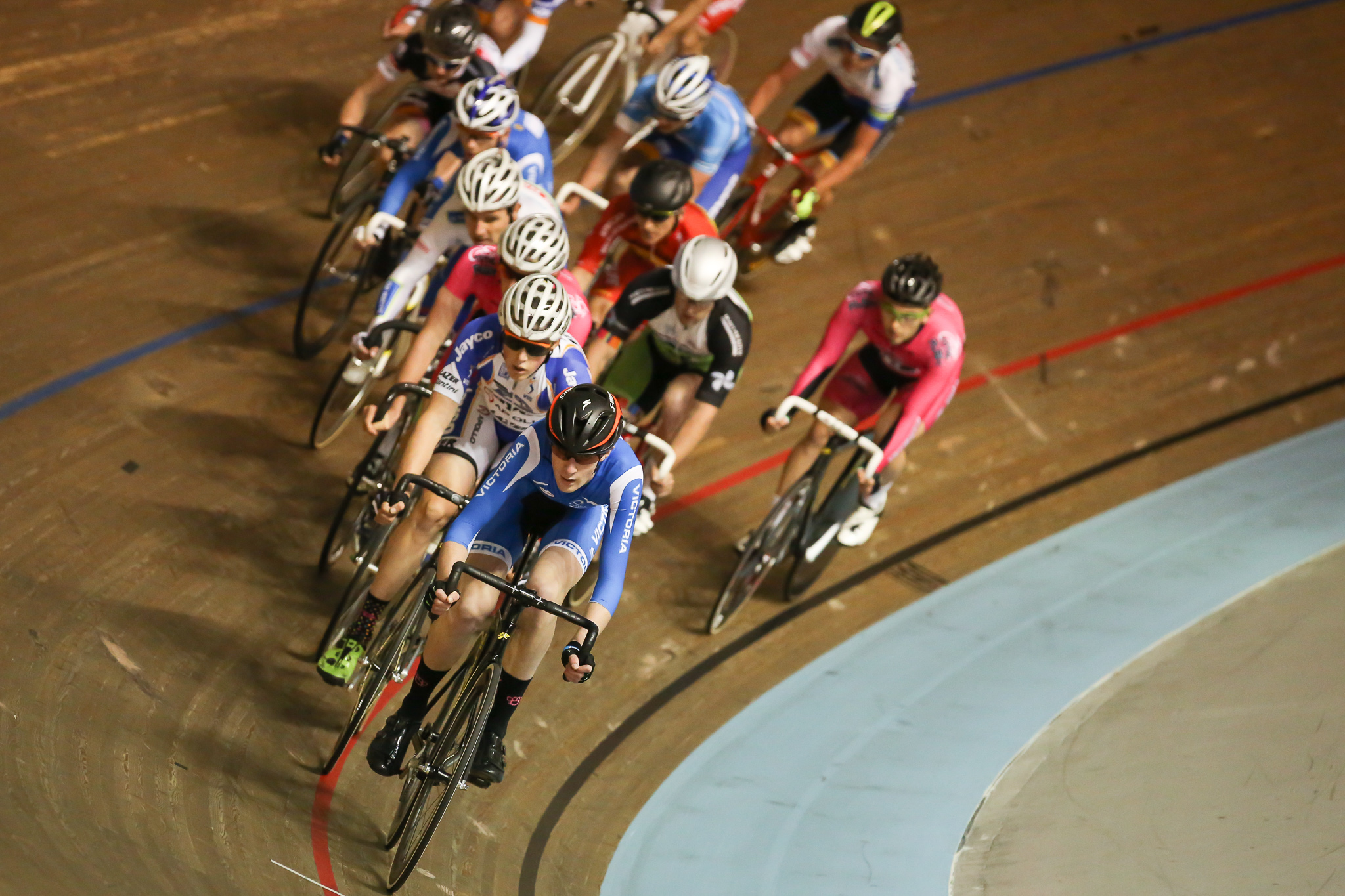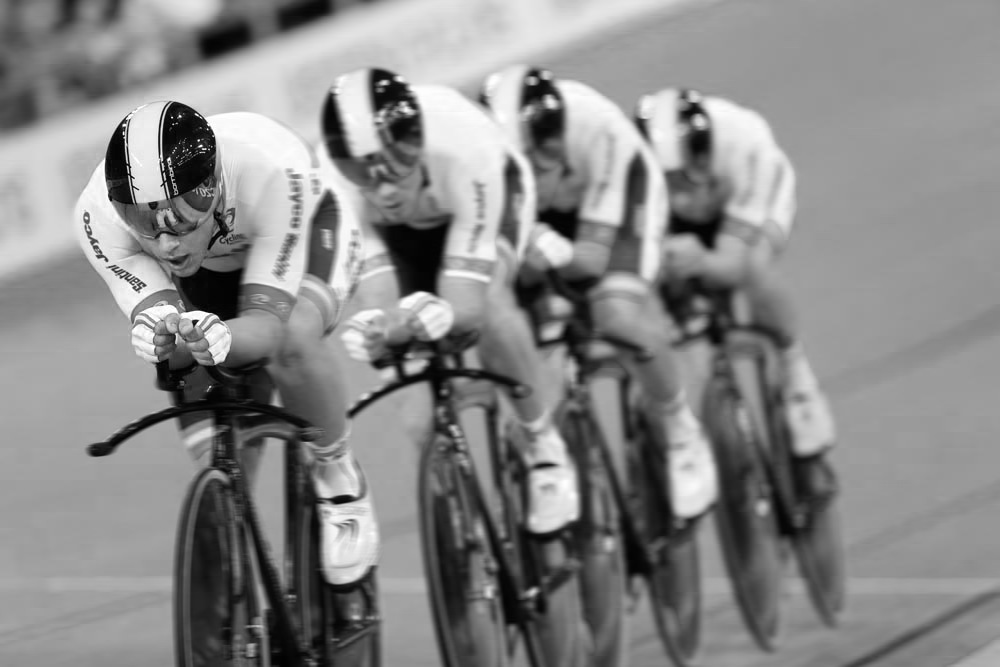Track Cycling Events Explained
Track Cycling Events Explained
While this list doesn’t cover every track discipline, it covers the most common events. Broadly speaking, events can be classified into “sprint” and “endurance” events. For the newcomer and experienced punter alike, certain track cycling events can be a complete mystery. The following is a simple description of the races that will attempt to explain the basics of each event.
Sprint events
Match Sprint (Men/Women)
Traditionally held over 750m-1000m (3 laps), this event captures the essence of track cycling, although it is the most mysterious. Although it is normally a one-on-one event, earlier rounds can feature three or more cyclists on the track at the same time. One rider is designated to lead for the first lap (usually by a coin toss), and can not relinquish it unless those behind take it from him/her. The competitors typically eye each other off for the first 6-700 metres, trying to manoeuvre each other into an unfavourable position, before launching an explosive sprint for the last 200 metres, which is the only part of the event that is timed. The first across the line wins the race.
Tactics are the key to this race, and many people wonder why it is so slow for the first two laps. The main reason is that unless you can surprise your opponent early, you will waste too much precious energy in starting your sprint from lap one. If the other rider is on your wheel, it’s all over.
An important rule is that of ‘possession’ underneath the sprinter’s line, a line marked 80 cm from the pole line near the base of the track. A rider who positions themselves below this line in the final 200 metres is not allowed to be forced out by another rider e.g. pushing in from the inside. This is one of the most often broken rules causing reversals in sprint results.
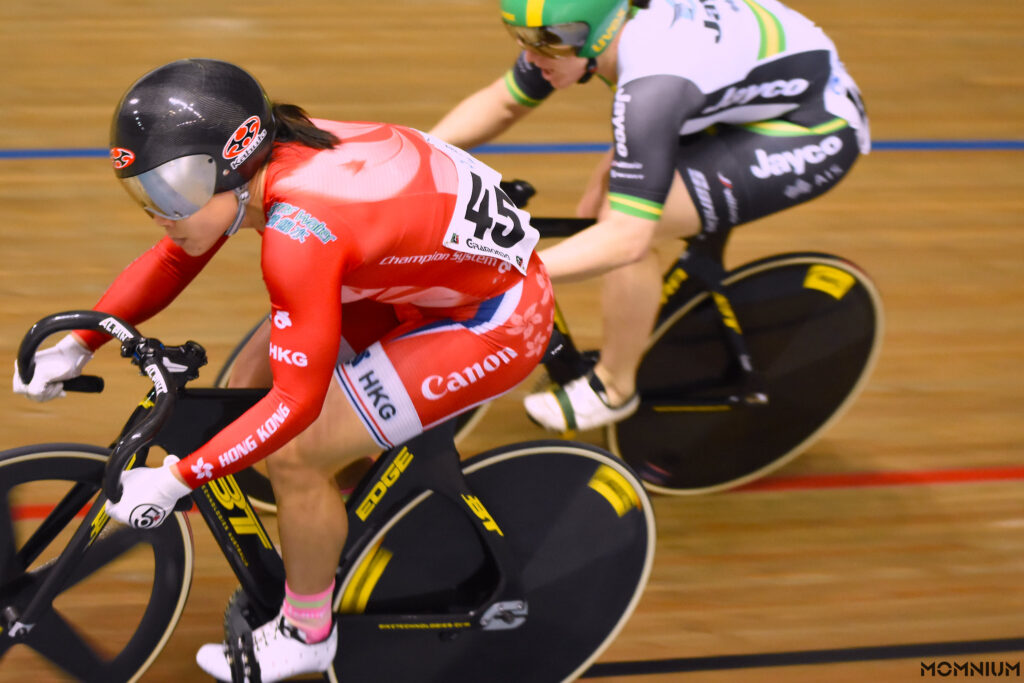
1,000 m Time Trial (Men)
Probably the most painful of track disciplines, the “kilo” as it is known commonly is raced as a time trial over 1000 metres. To do well in this event you have to have an explosive start, good top speed, and endurance to carry you through the last few hundred metres where the lactic acid buildup in your legs becomes almost intolerable.
The kilo was Australian track legend Shane Kelly’s primary event. The current record is 56.303 seconds, by François Pervis of France, recorded on 7 December 2013. Previously the record of 58.875 seconds was held by Arnaud Tournant of France. Tournant was the first rider to break the one minute barrier, lowering his own previous record of 1.00.148.
In this event, two riders often start on opposite sides of the track although it is essentially an individual event.
500 m Time Trial (Women)
Held over half the distance of the men, the women’s 500m time trial requires explosiveness as well as good top speed. Typically, the fastest 200m rider is also the best over 500, although this is not always the case. It is different to the men’s race with respect to the endurance required. Anna Meares of Australia currently holds the world record of 32.836 seconds set on 6 December 2013.
Team Sprint (Men/Women)
A three rider time trial held over three laps of the velodrome, with teams starting on opposite sides of the track. After the end of each lap, the leading rider pulls off completely, leaving the next to fight the wind. Therefore, the first rider has to do one laps, the second, two laps, and the last rider three laps. Hence, rider number three typically has the best endurance: A good kilometre time trial rider e.g. Arnaud Tournant or Shane Kelly is chosen for this position.
Keirin (Men/Women)
The keirin is a motorpaced event that is very popular in Japan where it originated. In that country, huge amounts of money are bet on races and professional keirin riders command impressive salaries.
It is similar to the match sprint, but features 6-8 riders on the track. A derny motorbike paces the riders from 25 km/h up to 45 km/h for the first few laps. During this time, riders jostle each other for the best position and this is often the roughest part of the event. With two and a half laps to go, the derny bike pulls off and the sprint is on. Team tactics are important here, as the leadout is often quite long. If one team can get two of their riders in the final, then they are at a distinct advantage.
Endurance events
Scratch (Men/Women)
In track cycling, a scratch race is the simplest race of all whereby all riders start together and the object is simply to be first over the finish line after a certain number of laps. There are no intermediate points or sprints. UCI regulations specify that a scratch race should be held over 15 km for Elite Men and 10 km for Elite Women. Shorter distances of 10 km for men and 7.5 km for women may be used for qualifying rounds. Typically, we run our events over 10 km for the elite women and men.
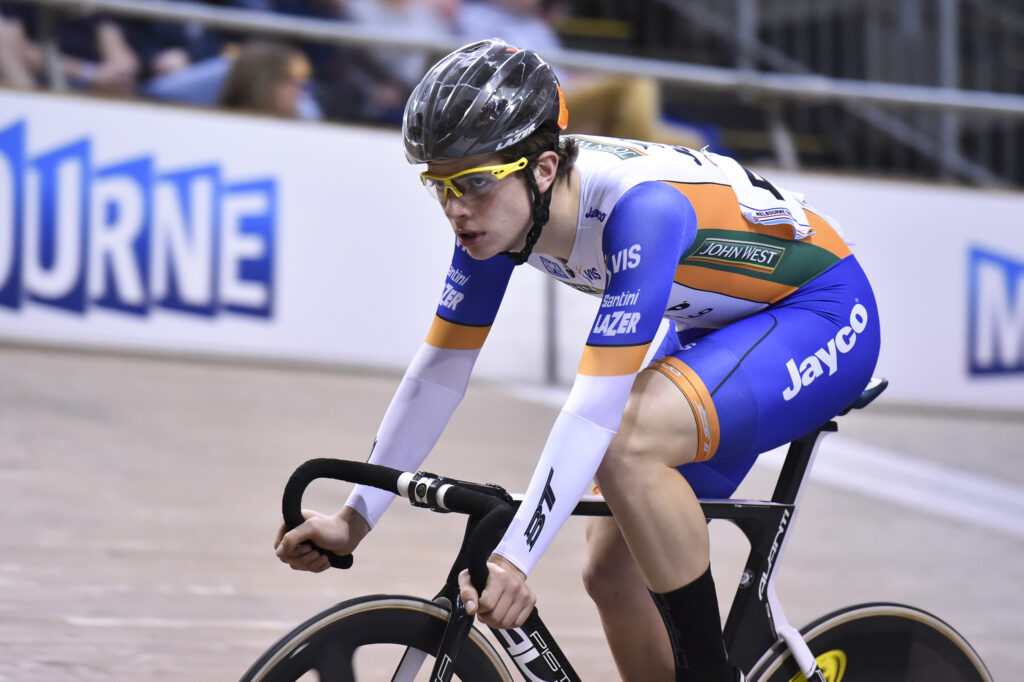
Elimination (Men/Women)
Elimination races in track cycling are a form of race wherein during the course of the race, participants are eliminated through various criteria. The most common types of elimination races are the Miss and Out and the Win and Out.
The Miss and Out or Devil Take the Hindmost is a race run for individual competitors or, more rarely, for teams of two relaying each other as in the Madison. At the end of every lap or every set number of laps the last rider to cross the line is eliminated from the race. When just a handful of riders remain, they sprint for the finish.
Tactically, the real racing in a “devil” happens at the back of the field. With riders at the front riding steadily and those behind moving up on the elimination laps to find a safe spot, the race favours riders with nerve and track-craft. The telescoping of the field means crashes are more common than in other races, especially among inexperienced riders.
The Win and Out is similar to the Miss and Out, however, rather than the last rider being eliminated the first rider to cross the line is removed from the race. The first rider removed wins first place, the second rider removed wins second place, and so on.
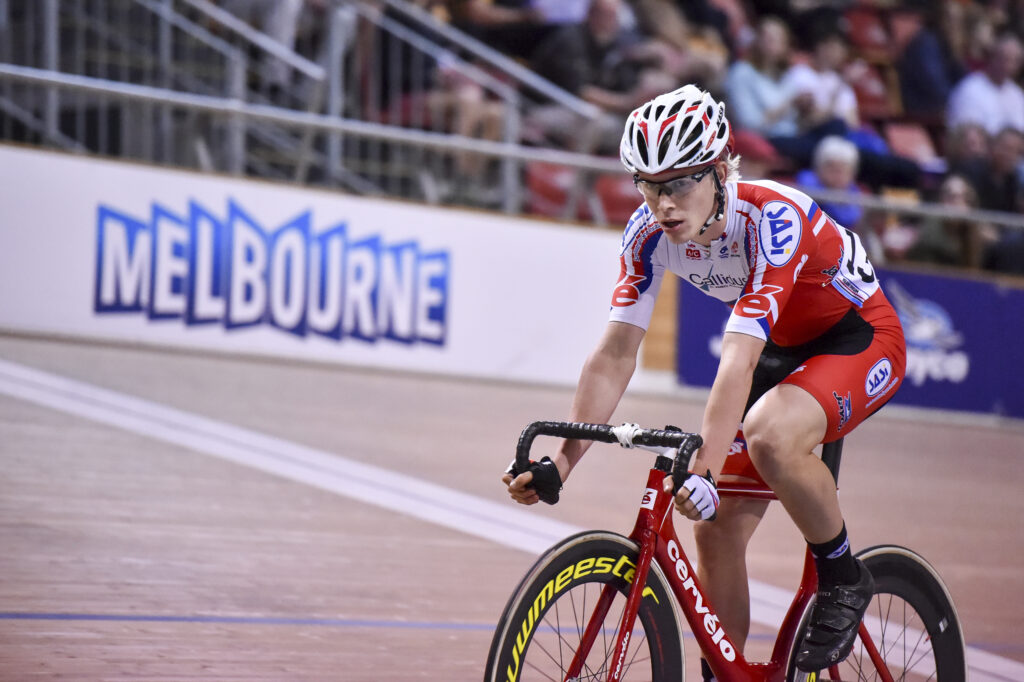
Individual Pursuit (Men/Women)
Held over 4000 metres for elite men and 3000 metres for elite women (shorter for masters riders), this is considered an “endurance” track event, although the speeds are still extremely high. Two riders start on opposite sides of the track and try to set the fastest time over the allotted distance. Normally, a qualifying time trial is ridden that determines who is eligible for the semi finals and finals. The fastest ride is often produced here, as in the finals, the only important criterion is to beat your opponent. If one rider catches the other, i.e. puts half a lap into them, then the race is over.
An explosive start is not critical (but it’s handy to have), however the ability to ride at a consistently high speed is far more important. Many riders who go out too hard can look to be well up on their opponent, only to fade in the last 1000 metres. This has typically the greatest “cross-over” to the road. i.e. good pursuiters make good road riders and vice versa. Bradley Wiggins, Rohan Dennis, Stuart O’Grady, Vjatcheslav Ekimov, and Chris Boardman are a few examples of top pursuiters who have had successful road careers.
The current world record was set in 2011 by Jack Bobridge of Australia in a time of 4:10.534.
Team Pursuit (Men/Women)
This event is raced by the men only, and held over 4000 m. Faster than the individual pursuit, although it is still an endurance event, the team pursuit is about clockwork precision as well as high speed. Two four man teams start on opposite sides of the track and try to set the fastest time over the distance as with the individual pursuit. The time taken is on the third rider to cross the line.
Riders must follow each other at a few cm difference to gain the maximum drafting effect from the rider in front. Following a wheel closely is a vital skill, but stuff-ups still happen, as the Ukrainian team showed at the 1997 Worlds in Perth. A wheel touch in the final brought down the whole team down and cost them the event.
Turns of pace are often half a lap, although the stronger riders can do full lap turns. The world record for this event of 3:51.659 was set at the London Olympic Games by the United Kingdom in 2012. This was an average speed of over 60 km/h from a standing start!
Madison (Men/Women)
This race is named after Madison Square Garden in New York where the event was first held (also called “Americaine” in French. Two man teams contest the event, which is typically 50-60 kilometres. After a mass start where all riders are on the track, only one rider from each team is allowed in the race at a given time, meaning that teams must take it in turn each lap (or more) to have a rider in the race. Changeovers are quite dangerous, but impressive to watch when done well – one rider circles around waiting for his teammate, who joins hands and imparts his momentum to the slower rider.
To win the madison, the team must score points by sprinting every 20 laps for bonuses (5, 3, 2, 1 points). The last lap usually counts for double points, but the winner of this does not necessarily win the event. Also, if a team can gain a lap on the field, then they are in the leading position of the race no matter how many points they have.
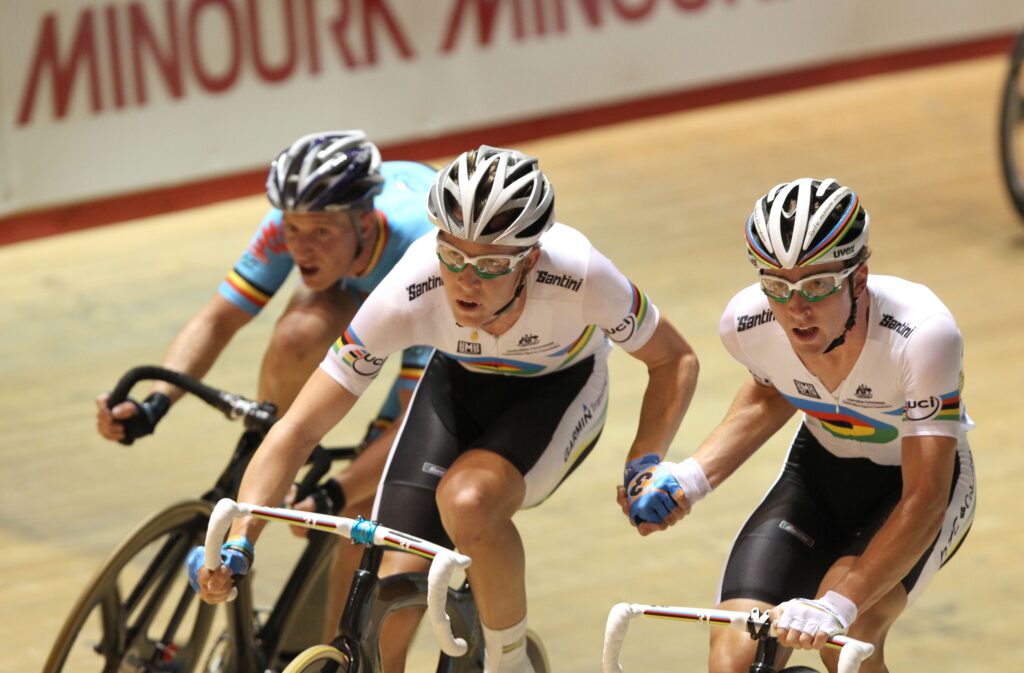
Points Race (Men/Women)
This is a solo event, scored similarly to the madison and raced by both men and women. Again, a rider scores points in intermediate bonus sprints every 10th lap (5, 3, 2, 1) with double points usually awarded on the last lap. If a rider can lap the field, then they get 20 points, which can be enough to secure the win – but not always. If a rider drops back a lap, they will have 20 points deducted from their total, so you sometimes see riders with negative scores.
The Hour Record
One track event stands outside and above typical track events: the hour record. This is a simple test of ability to cover distance in 60 minutes and both UCI and Absolute records are currently held by Brit Chris Boardman. In 1996, Boardman rode 56.375 kilometres around Manchester velodrome using the now outlawed “superman position”. In October 2000, he rode 49.441 kilometres on a UCI standardised bike: a steel tubed triangular frame with spoked wheels and no aero helmet.
Since the UCI, cycling’s world governing body, unified the regulations surrounding the event last year, four riders have held the record: Germany’s Jens Voigt, Matthias Brandle of Switzerland, Australian Rohan Dennis, Alex Dowsett and Bradley Wiggins. Victor Campenaerts of Belgium is the current record holder at 55.089 km.
The women’s hour records are held by French great, Jeannie Longo, who rode 48.159 kilometres in 1996 (Absolute Record) and by Vittoria Bussi, who rode 48.007 kilometres in 2018 (UCI Record).
The Omnium
An omnium (from Latin: of all, belonging to all) is a multiple event competition whereby the overall winner is the most consistent rider across the events. As defined by the Union Cycliste Internationale (UCI), the Onnium consists of the following six events held over 2 days:
- Scratch race
- Tempo race
- Elimination race
- Points race
For the first three events, each winner shall be awarded 40 points, each second place shall be awarded 38 points, each third place shall be awarded 36 points, etc. Riders ranked 21st and below will each be awarded 1 point. In the Points Race, riders shall add to, and lose points from, their points total based on laps gained and lost, and points won in sprints.
The winner of the Omnimum is the rider who has obtained the highest total of points. In the event of a tie in the final ranking, the places in the final sprint of the last event – the Points Race – shall break the tie. A rider must complete every event in the omnium to be eligible for the overall ranking.
Share this content:
